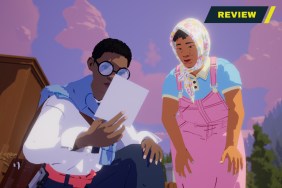The Dark Pictures Anthology has had a rough start. Man of Medan was a semi-turbulent debut while Little Hope, the second entry, deserved to be burned at the stake. House of Ashes is the third entry and takes the series to Iraq circa 2003. It’s a unique place and time that’s ripe for a horror game and while it is the best of the trio, it’s still a clumsy narrative game filled with technical shortcomings, peculiar pacing, and wonky animation.
However, most of House of Ashes’ best parts are derived from its setting. As the prior Dark Pictures games showed, horror is usually banished to creepy houses, ships, or otherwise dank places. Putting a horror game in the dry deserts of the Middle East is almost unheard of, especially in video games, and that change of scenery is inherently intriguing. Different scenarios open up the potential for different scares in the same way tired settings pave the way for tired scares, as was seen in Man of Medan’s ghost ship and Little Hope’s cursed town.
But it’s the time that gives the place more meaning. House of Ashes is set just after the United States invasion of Iraq around 2003 where jingoistic lies about weapons of mass destruction and demonization of Middle Eastern people were still being quickly propagated by the slowest idiots. Putting the game in the center of that conflict better positions it to actually tackle real issues in some way, which is a far cry from games like 2019’s Call of Duty: Modern Warfare that hide behind fake country names to more safely steep in the comforts of “fiction.”
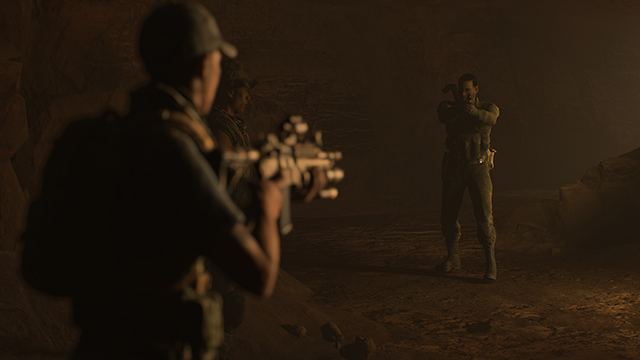
House of Ashes veers right into non-fictional territory with its premise. A group of American soldiers is convinced they’ve found a silo of Saddam Hussein’s chemical weapons and raid a small rural farm in an attempt to seize them. Bad intel, a surprise attack from the Republican Guard, and an earthquake turns the operation on its head and the soldiers plummet into newly opened cracks in the sand, stumbling upon a subterranean Ancient Sumerian temple.
Kicking the game off with a failed raid for weapons is a blunt way to draw parallels to the real world and it mostly works. As on the nose as it is, having something catastrophic unfold after said raid does speak volumes about the Iraq War. One of the Americans, Nick, even repeatedly criticizes the war and their actions in different ways throughout the game, bringing some necessary nuance to the ordeal and ensuring that the setting isn’t just a hollow backdrop free from examination. Some past war crimes are oddly brushed off and some of the inhumane characters have no arc, but there’s more than enough to avoid being a mealy-mouthed sanitization of the conflict.
Salim, the lone Iraqi protagonist, also brings a unique perspective to the conflict while also shying away from the nationalism war oftentimes brings. He’s one of the more memorable people because of it, making it puzzling why Supermassive didn’t include even more Iraqi characters as it is a viewpoint so rarely seen in video games.
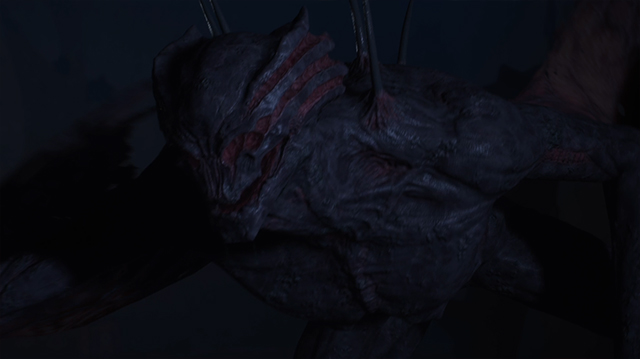
And as the characters fall deeper into the earth, the story gets deeper as well, but it does take some time. After a well-edited and choreographed prologue that carefully introduces them, the bat-like creatures become the main antagonist and add even more tension to the already-tense situation. They’re thoughtfully designed and bring in elements of classic movie monsters without directly copying them, resulting in a familiar yet different beast.
They don’t initially feel like anything more than a classic fanged monstrosity meant to maim the protagonists. But House of Ashes eventually goes into their lore in ways that call back to its themes and setting. Some of it is glossed over and it’s not all done gracefully, but it’s clever and demonstrates how a well-designed monster can meaningfully add to horror on multiple levels if done well.
Finding more about the batty gargoyles takes center stage in the final act, which is where the game is at its best. It begins to subvert expectations, present its best scenarios, and add some gameplay mechanics that are more than just walking forward without much thought. But it just takes too long to get to that point and front-loads all of its most cliché and boring bits and turns the buildup into a chore.
Most of the game revolves around walking forward down a narrow corridor with a camera that’s too close and obscures the view ahead. Tightening the viewpoint to make the player feel claustrophobic is one thing, but the weighty movement and widescreen bars on the top and bottom of the screen just make it more frustrating than scary (although, thankfully, it doesn’t overly rely on jump scares this time). And this happens over and over again and is never as tense as the game wants it to be.
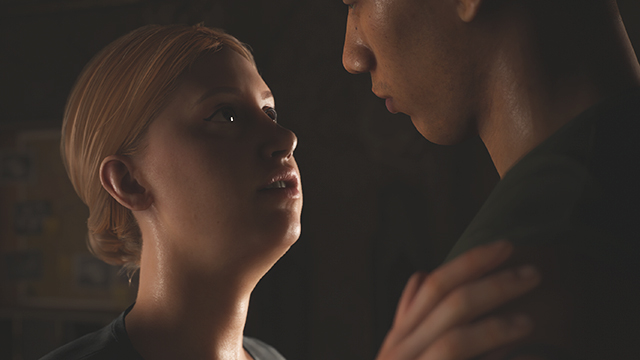
The characters are at their most annoying during the first two acts and while the writing is serviceable, the animation for the humans is jerky (although the animalistic animation for the beasts is incredible). Faces can animate well sometimes, but they’ll often lack expression, which the game oddly points out during its slow-motion bits. Character models are extremely detailed yet some have weirdly shaped heads with bloated throats that make them look like they have goiters, a bad case of the mumps, or just recently unhinged their jaw and swallowed a rabbit whole.
These weirdly proportioned heads are paired with weirdly animated bodies. A lifelike performance occasionally will shine through, but most of the time these lost souls look like a bunch of stiff mannequins taking an acting class at a community college. Eyelines also contribute to this robotic feeling as characters hardly ever look at who they’re speaking to. Combined with the line reads that feel right out of The Room and Supermassive has journeyed so far into the uncanny valley that it begins to feel more like the uncanny Mariana Trench.

House of Ashes is rough in many other areas, too. Some scenes overly rely on intercutting in a way that completely obliterates its forward momentum. Its forced inclusion of simultaneous co-op means that solo players frequently just watch for longer periods of time. Switching between characters in couch co-op is jarring, especially during action scenes, and the game will bring up the switching prompt even when that person is already playing. Load times pop up in odd places and further cut the pacing.
Faster load times on the PlayStation 5 (and presumably, Xbox Series X|S) can alleviate some of the pacing issues, but the last generation is hamstrung quite a bit by slower drives that add an unnecessary commercial break to many scenes. And this is doubly bad since the PS4 (and, again, presumably the Xbox One) version is much worse in most aspects, even when running through backwards compatibility.
The PS4 port is significantly buggier than the PS5 version and full of distracting glitches. Many textures were blurry or failed to load in. Certain rocks would glow bright pink or orange. Weapons regularly floated in mid-air. Ejected shell casings sometimes float around as if they were floating in space. Speaking characters don’t always move their mouths. While it still looked relatively solid, it was a technical mess when compared to its current-gen iterations.
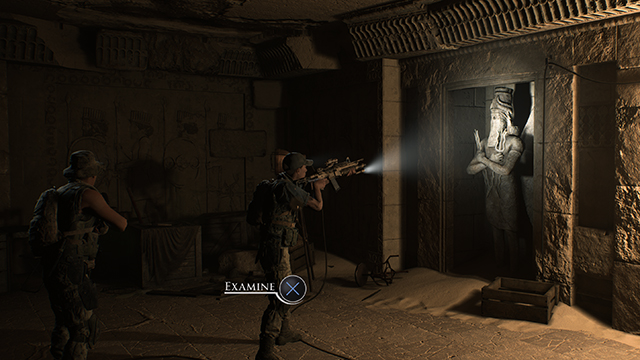
House of Ashes does improve on some aspects of The Dark Pictures‘ formula with its wealth of accessibility settings, three difficulty modes, and less intrusive aiming reticle. But it needs to make bigger steps forward, which means having more meaningful branches and not becoming so dependent on quick-time events. Repeat playthroughs might bring minor variations to certain scenes, but running through it again will likely just point out the game’s illusion of choice.
Having more choice would strengthen the game, especially if those choices were baked into the more interactive portions. Some parts of the game reward players for exploring and finding helpful items yet those bits are few and far between. One part even rewards those that pay attention to their footsteps. Both of these allow players to more organically engage with the game and change the story in ways that are more involved than just pressing the X button at the right time.
House of Ashes has a distinct setting with themes and twists that give it more meaning and style when compared to its other Dark Pictures brethren. It is unequivocally the best thing Supermassive has made since Until Dawn. But that bar is pathetically low as the five console horror games following that unexpected 2015 hit have been all mediocre or downright terrible. House of Ashes is getting close enough to the surface to see sunlight beaming through the cracked bits of earth above, but it’s still stuck underground.
SCORE: 6.5/10
As ComingSoon’s review policy explains, a score of 6.5 equates to “Decent.” It fails to reach its full potential and is a run-of-the-mill experience.







